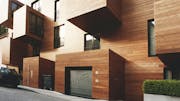Classic timber construction is back in vogue
Marta Aras, 4 December 2018
The issue of sustainability influences today's building industry and leads back to the well-known timber construction.

The topic of sustainability is omnipresent and is also of great importance in the building industry. There are various ways to build and live sustainably. As one of many possibilities, today we present timber construction from different perspectives.
Centuries ago, carpenters built houses out of wood and acquired a great deal of knowledge in the use of wooden buildings. In recent decades, solid construction has dominated, but now building with wood is becoming more popular again. With new techniques and building systems, trendy homes can be built. Many people are interested in sustainability and the modern, durable timber buildings offer various advantages in this respect. With the renaissance of this old trend, various questions about this construction method are emerging.
Shorter building time thanks to wood
Before you can start building your own home, everything has to be planned and organised in detail. Building with wood has several advantages and disadvantages. The construction and assembly time is very short. However, wood is a light building material, so the protection against sound is not complete. The advantage of the low weight is the possibility to prefabricate many construction elements, which can further speed up the building process. Furthermore, wood can be heavily loaded, which offers unlimited design possibilities. However, one must not forget that space must be created for planned electrical installations. Thus, electrical planning in advance takes more time than with an ordinary solid construction.
Ecological living in wooden construction
Besides the short construction time, living in a wooden house offers further advantages. The focus is clearly on environmental friendliness. Wood is a renewable raw material that is sustainably managed in the forests of Switzerland. One third of the country is made up of forest and more wood actually grows than is consumed. From this perspective, the forests in Switzerland are not endangered by the use of wood for housing. It is ecological material and what is left over goes back into the biological cycle. It is not only the processing of wood that requires little energy. Energy can also be saved when living, because wood stores heat and therefore less heating is needed in winter. In summer it can get very hot, but with modern systems pleasant temperatures are possible even on hot days.
Healthy living
Ecological living makes it possible to live healthily at the same time. Wood is a natural and breathable material, which provides a cosy living climate with all the comforts. Thanks to the good indoor climate, there is optimal humidity. This provides the necessary feel-good factor. However, since wood is alive, there are various disadvantages. It can shrink, lead to cracks and, depending on the type of wood, it has to be painted every four to ten years. Nevertheless, living in an environmentally friendly built house is something special and healthier than in solid buildings.
Risks due to fires in timber construction?
Many assume that a wooden building is more vulnerable to fires. Wood is combustible, but the speed of the fire is slow, steady and predictable. The risk of fire is exactly the same as in other houses. In fact, it is mainly the furniture that catches fire during the fire. In addition, strict regulations apply in Switzerland and we have the lowest number of deaths from fires in the world. If a fire does occur, at least no toxic gases or pollutants are produced.
Eco-friendly living can therefore start with the choice of building material for your home. If you care a lot about the style of construction and the raw materials used, this article may have encouraged you to build your home out of wood. But no matter what you choose, it is important that you feel comfortable in your home.

